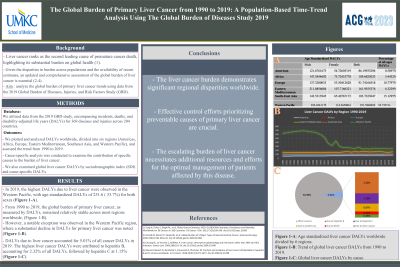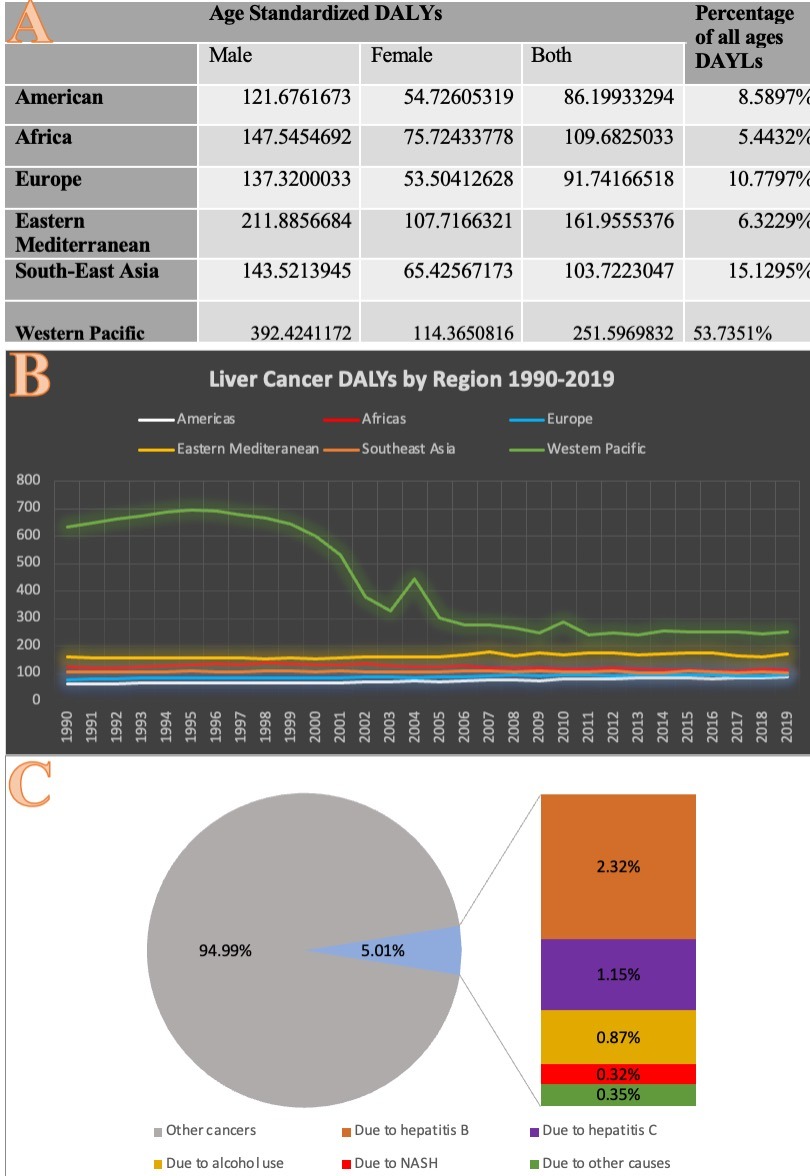Sunday Poster Session
Category: Liver
P0904 - The Global Burden of Primary Liver Cancer from 1990 to 2019: A Population-Based Time-Trend Insights Using the Global Burden of Diseases Study 2019
Sunday, October 22, 2023
3:30 PM - 7:00 PM PT
Location: Exhibit Hall


Fouad Jaber, MD
University of Missouri-Kansas City
Kansas City, MO
Presenting Author(s)
Fouad Jaber, MD1, Saqr Alsakarneh, MD1, Anika Mittal, MS1, Saeed Abughazaleh, MD2, Hamza Alzghoul, MD3, Azizullah Beran, MD4, Mohamed Ahmed, MD1, Mohammad Jaber, MD5, Leen Al-Sayyed, MD6, Thaer Abdelfattah, MD, MPH7, Suha Abushamma, MD8, Natalie Wilson, MD9, Yassine Kilani, MD10, Mir Zulqarnain, DO1, John Helzberg, MD1
1University of Missouri-Kansas City, Kansas City, MO; 2St. Elizabeth's Medical Center, Tufts University School of Medicine, Brighton, MA; 3University of Central Florida, Gainesville, FL; 4Indiana University, Indianapolis, IN; 5Al-Azhar University, Gaza, Palestinian Territories; 6Saint Louis University, St. Louis, MO; 7Allegheny Health Network, Pittsburgh, PA; 8Cleveland Clinic, Cleveland, OH; 9University of Minnesota, Minneapolis, MN; 10Lincoln Medical Center, New York, NY
Introduction: Liver cancer ranks as the second leading cause of premature cancer death, highlighting its substantial burden on global health. Given the disparities in burden across populations and the availability of recent estimates, an updated and comprehensive assessment of the global burden of liver cancer is essential. In this study, we analyze the global burden of primary liver cancer trends using data from the 2019 Global Burden of Diseases, Injuries, and Risk Factors Study (GBD).
Methods: We utilized data from the 2019 GBD study, encompassing incidents, deaths, and disability-adjusted life years (DALYs) for 369 diseases and injuries across 204 countries. We plotted and analyzed DALYs worldwide, divided into six regions (Americas, Africa, Europe, Eastern Mediterranean, Southeast Asia, and Western Pacific), and assessed the trend from 1990 to 2019. In addition, cause-specific analysis was conducted to examine the contribution of specific causes to the burden of liver cancer. Also, we examined global liver cancer DALYs by sociodemographic index (SDI) and cause-specific DALYs.
Results: In 2019, the highest DALYs due to liver cancer were observed in the Western Pacific, with age-standardized DALYs of 251.6 ( 53.7%) for both sexes (Figure 1-A). Southeast Asia and Europe followed, accounting for 103.7 (15.1%) and 91.7 (10.7%) of all DALYs due to liver cancer in 2019, respectively. From 1990 to 2019, the global burden of primary liver cancer, as measured by DALYs, remained relatively stable across most regions worldwide, (Figure 1-B). However, a notable exception was observed in the Western Pacific region, where a substantial decline in DALYs for primary liver cancer was noted (Figure 1-B). DALYs due to liver cancer accounted for 5.01% of all cancer DALYs in 2019. The highest liver cancer DALYs were attributed to hepatitis B, accounting for 2.32% of all DALYs, followed by hepatitis C at 1.15% (Figure 1-C). Furthermore, there were variations in DALYs by SDI, with the medium SDI regions showing the highest DALYs and the low SDI regions displaying the lowest DALYs.
Discussion: The liver cancer burden demonstrates significant regional disparities worldwide. Effective control efforts prioritizing preventable causes of primary liver cancer are crucial. The escalating burden of liver cancer necessitates additional resources and efforts for the optimal management of patients affected by this disease.

Disclosures:
Fouad Jaber, MD1, Saqr Alsakarneh, MD1, Anika Mittal, MS1, Saeed Abughazaleh, MD2, Hamza Alzghoul, MD3, Azizullah Beran, MD4, Mohamed Ahmed, MD1, Mohammad Jaber, MD5, Leen Al-Sayyed, MD6, Thaer Abdelfattah, MD, MPH7, Suha Abushamma, MD8, Natalie Wilson, MD9, Yassine Kilani, MD10, Mir Zulqarnain, DO1, John Helzberg, MD1. P0904 - The Global Burden of Primary Liver Cancer from 1990 to 2019: A Population-Based Time-Trend Insights Using the Global Burden of Diseases Study 2019, ACG 2023 Annual Scientific Meeting Abstracts. Vancouver, BC, Canada: American College of Gastroenterology.
1University of Missouri-Kansas City, Kansas City, MO; 2St. Elizabeth's Medical Center, Tufts University School of Medicine, Brighton, MA; 3University of Central Florida, Gainesville, FL; 4Indiana University, Indianapolis, IN; 5Al-Azhar University, Gaza, Palestinian Territories; 6Saint Louis University, St. Louis, MO; 7Allegheny Health Network, Pittsburgh, PA; 8Cleveland Clinic, Cleveland, OH; 9University of Minnesota, Minneapolis, MN; 10Lincoln Medical Center, New York, NY
Introduction: Liver cancer ranks as the second leading cause of premature cancer death, highlighting its substantial burden on global health. Given the disparities in burden across populations and the availability of recent estimates, an updated and comprehensive assessment of the global burden of liver cancer is essential. In this study, we analyze the global burden of primary liver cancer trends using data from the 2019 Global Burden of Diseases, Injuries, and Risk Factors Study (GBD).
Methods: We utilized data from the 2019 GBD study, encompassing incidents, deaths, and disability-adjusted life years (DALYs) for 369 diseases and injuries across 204 countries. We plotted and analyzed DALYs worldwide, divided into six regions (Americas, Africa, Europe, Eastern Mediterranean, Southeast Asia, and Western Pacific), and assessed the trend from 1990 to 2019. In addition, cause-specific analysis was conducted to examine the contribution of specific causes to the burden of liver cancer. Also, we examined global liver cancer DALYs by sociodemographic index (SDI) and cause-specific DALYs.
Results: In 2019, the highest DALYs due to liver cancer were observed in the Western Pacific, with age-standardized DALYs of 251.6 ( 53.7%) for both sexes (Figure 1-A). Southeast Asia and Europe followed, accounting for 103.7 (15.1%) and 91.7 (10.7%) of all DALYs due to liver cancer in 2019, respectively. From 1990 to 2019, the global burden of primary liver cancer, as measured by DALYs, remained relatively stable across most regions worldwide, (Figure 1-B). However, a notable exception was observed in the Western Pacific region, where a substantial decline in DALYs for primary liver cancer was noted (Figure 1-B). DALYs due to liver cancer accounted for 5.01% of all cancer DALYs in 2019. The highest liver cancer DALYs were attributed to hepatitis B, accounting for 2.32% of all DALYs, followed by hepatitis C at 1.15% (Figure 1-C). Furthermore, there were variations in DALYs by SDI, with the medium SDI regions showing the highest DALYs and the low SDI regions displaying the lowest DALYs.
Discussion: The liver cancer burden demonstrates significant regional disparities worldwide. Effective control efforts prioritizing preventable causes of primary liver cancer are crucial. The escalating burden of liver cancer necessitates additional resources and efforts for the optimal management of patients affected by this disease.

Figure: Figure 1-A: Age standardized liver cancer DALYs worldwide divided by 6 regions.
Figure 1-B: Trend of global liver cancer DALYs from 1990 to 2019.
Figure 1-C: Global liver cancer DALYs by cause.
Figure 1-B: Trend of global liver cancer DALYs from 1990 to 2019.
Figure 1-C: Global liver cancer DALYs by cause.
Disclosures:
Fouad Jaber indicated no relevant financial relationships.
Saqr Alsakarneh indicated no relevant financial relationships.
Anika Mittal indicated no relevant financial relationships.
Saeed Abughazaleh indicated no relevant financial relationships.
Hamza Alzghoul indicated no relevant financial relationships.
Azizullah Beran indicated no relevant financial relationships.
Mohamed Ahmed indicated no relevant financial relationships.
Mohammad Jaber indicated no relevant financial relationships.
Leen Al-Sayyed indicated no relevant financial relationships.
Thaer Abdelfattah indicated no relevant financial relationships.
Suha Abushamma indicated no relevant financial relationships.
Natalie Wilson indicated no relevant financial relationships.
Yassine Kilani indicated no relevant financial relationships.
Mir Zulqarnain indicated no relevant financial relationships.
John Helzberg indicated no relevant financial relationships.
Fouad Jaber, MD1, Saqr Alsakarneh, MD1, Anika Mittal, MS1, Saeed Abughazaleh, MD2, Hamza Alzghoul, MD3, Azizullah Beran, MD4, Mohamed Ahmed, MD1, Mohammad Jaber, MD5, Leen Al-Sayyed, MD6, Thaer Abdelfattah, MD, MPH7, Suha Abushamma, MD8, Natalie Wilson, MD9, Yassine Kilani, MD10, Mir Zulqarnain, DO1, John Helzberg, MD1. P0904 - The Global Burden of Primary Liver Cancer from 1990 to 2019: A Population-Based Time-Trend Insights Using the Global Burden of Diseases Study 2019, ACG 2023 Annual Scientific Meeting Abstracts. Vancouver, BC, Canada: American College of Gastroenterology.
